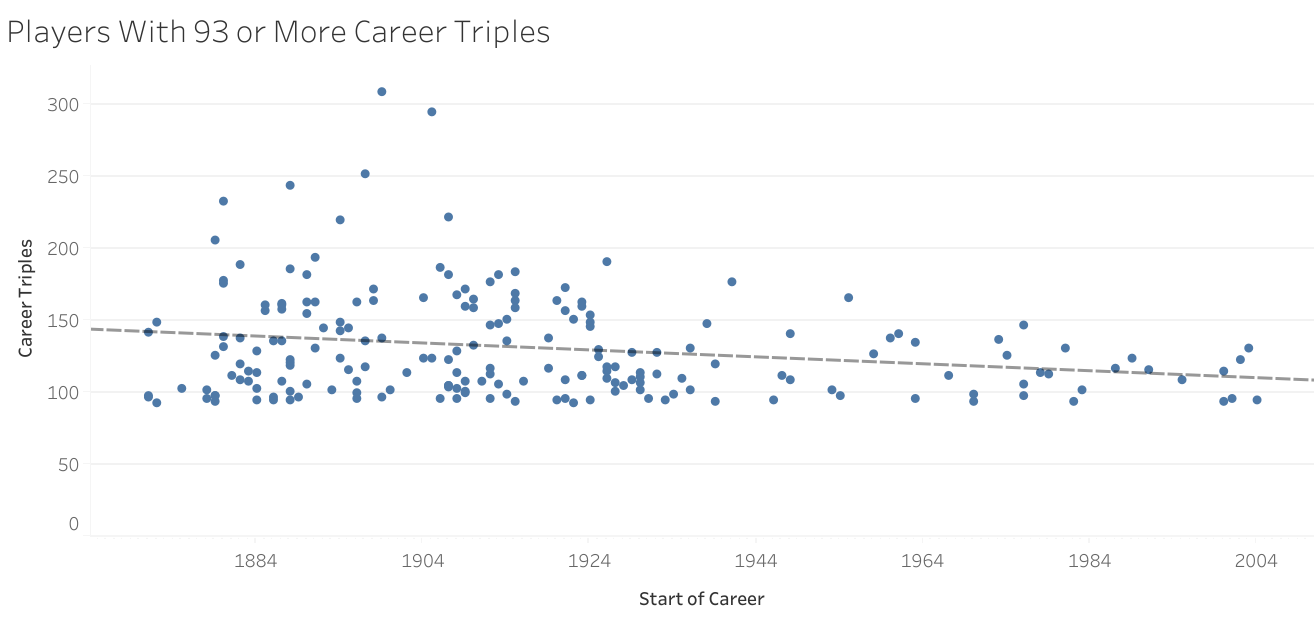Why the All-Time Triples Record Will Not Be Broken Any Time Soon
Triples just don’t have the value that they use to.
The golden age for triples in Major League Baseball ended nearly a century ago. A quick scan of the players at the top of the career list shows a bunch of players from the late 1800s and early 1900s. Topping the list with a seemingly insurmountable 309 triples is Sam Crawford. Number 2 on the list is his teammate of 13 years, Ty Cobb, with 295.
With the current state of the game (teams attempting to develop power hitters and often being less aggressive on the basepaths), it is hard to imagine any player in the next century coming even close to 300 triples. How hard is it to hit 300 triples in a career?
Well, if we look at the list of active players, Dexter Fowler comes out on top with 82 career triples (he doesn’t even make the minimum for the graph above). While that may not sound like a lot compared to Crawford’s 309, Fowler leads number 2, Alcides Escobar, by 26 triples. A huge part of Fowler’s triple prowess is likely playing at Coors Field. In his first 6 years in the majors, Fowler racked up an impressive 53 triples. It makes sense that Coors would be a great field for triples. One of the keys to hitting a lot of triples is ample outfield space. The outfielders need to spend some time tracking down the ball so the batter can make it past second base. In terms of modern fields, Coors is second only to Kaufmann Stadium. So, anyone with hopes of approaching just 200 triples (possibly just to get to 100 triples) would likely need to play most of their games on a field with a larger-than-average outfield.
Guys like Crawford and Cobb also displayed longevity and consistency that would be tremendously difficult to match. Crawford played 19 years in Major League Baseball and stayed remarkably healthy for most of them. In those 19 years, he hit at least 10 triples in all but his first and last seasons. If we added together the triple leaders from the last 19 full seasons (not including the shortened 2020), we would get a total of 271 triples. To remain a solid hitter for the majority of 19 years is incredibly difficult, but it can be just as difficult to retain the speed needed to hit triples consistently over those 19 years. For most players, more and more of those would-be triples become doubles because they simply cannot round the bases fast enough.
These stats really put the difficulty of hitting 300+ triples into perspective and show how hard the record is to break, but the most essential element of keeping this record intact may be the fact that most within Major League Baseball do not have a desire to hit triples. As mentioned earlier, many teams are focusing on power over-aggressive baserunning. Steals have declined throughout baseball for largely the same reason. Sending a guy from second to third on a close play is rarely worth the risk. When Sam Crawford played, baseball was largely played inside the fences. Players were incentivized by teams and fans to hit triples. The introduction of the home run and players’ increasing ability to hit home runs have greatly diminished the value of triples.
Ty Cobb’s career is a great example of the change in values that has taken place. Ty Cobb hit 0.366 over the course of 24 seasons and accumulated 4,189 hits. We still acknowledge the value of these numbers. Base hits are still important in today’s game, but fascination with the home run and a growing library of statistics have reinforced the home run’s stranglehold over singles. Interestingly, Cobb and Babe Ruth were inducted into the same Hall of Fame class, but it was Cobb who received more votes. Today, if we look at Wins Above Replacement, Ruth is listed as the second most valuable player behind only Barry Bonds. Ruth’s home runs loom large in debates about the greatest players in baseball history while Cobb’s triples often go unmentioned.
Data was obtained through baseballreference.com and their data on triple leaders.




